EXPERIENCE GRENOBLE
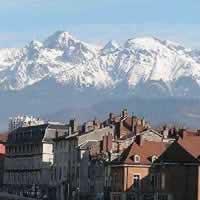
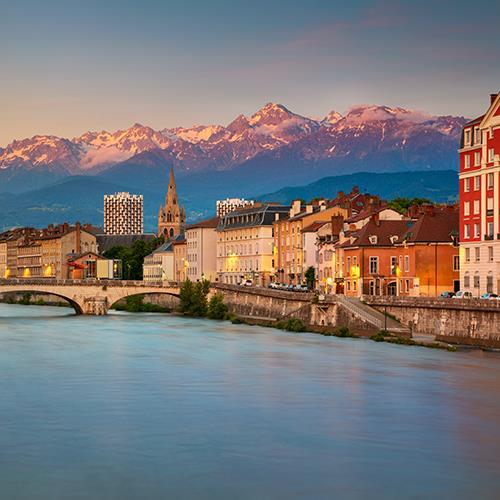
Overview
Surrounded by mountains, Grenoble is a beautiful place to spend a few days exploring. This 2,000-year-old city brings a lively and stunning nature together. It is filled with history observed through its archaeological sites, museums, and even its food.
The Isère River runs through the middle of the city, circling the clifftop Bastille and a beautiful set of riverside museums. On the opposite bank, Grenoble boasts a historic center lined with cafes and shops, world-class galleries and an efficient tram system that runs between surrounding neighborhoods.
Though it's surrounded by land preserved for nature, Grenoble is an industrial city, thanks in part to an economic boost from the 1968 Winter Olympics held here. The city is known for its winter sports, hiking, museums, universities and research centers. It’s also sometimes referred to as the capital of the Alps. It’s a pretty city surrounded by mountains and it sits in between the Drac and Isère rivers.



La Bastille Fortress
One of the top attractions in the city is the Bastille Fortress. Sitting on Mount Rachais overlooking the city, this century-old fortress dates back to the Middle Ages. In the 1800s it was used to defend France against invasions from its then rival, the Duchy of Savoy.
To arrive here, you can hike up to the top, or for an easier route, hop in one of the bubble-shaped cars of the Téléphérique de Grenoble Bastille cableway. The Téléphérique ride begins at Quai Stéphane-Jay at the edge of the Jardin de Ville, and travels through spectacular scenery on the way up to the Fort de la Bastille.
The Fort de la Bastille was formerly a prison; now it houses a contemporary art center, the Centre d'Art Bastille and a military museum (Musée des Troupes de Montagne).
For adventure seekers, the Acrobastille offers a chance to participate in mountaineering and acrobatic sports, such as ziplining, rappelling, and labyrinth courses. And for those who enjoy nature walks, there are many scenic trails around the fort.
The Fort de la Bastille's fine-dining restaurant, Chez le Pèr' Gras, offers traditional Dauphinois cuisine and stunning views. The outdoor patio has a romantic ambience under the linden trees.
Another gourmet option is the Restaurant O2 Téléphérique, which specializes in contemporary-style French cooking. This restaurant is more casual and has an outdoor terrace where guests can admire the city and mountain vistas.
The Fortress is best known for its stunning views of the rugged mountain ranges that surround the city. Just to the north lies the Chartreuse, to the south and west the Vercors, and to the east the Belledonne range. On days when visibility is clear, you can see Mont Blanc. The best spot for pictures of these views is from the terrace or the Vauban belvedere.
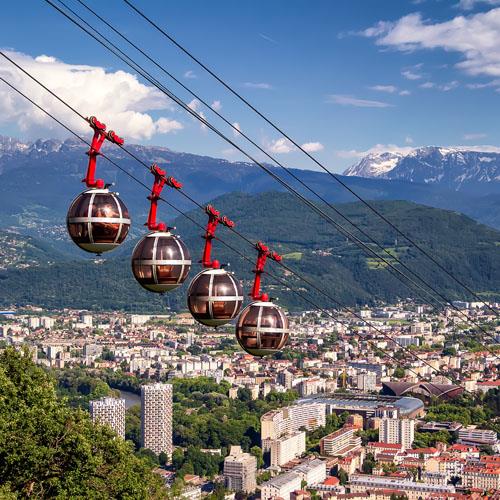
Grenoble-Bastille Cable Cars
The bubble shaped Grenoble cable car that takes visitors up to the Bastille Fortress offers a stunning vantage point of the Isere River, the forests, as well as the city of Grenoble below. Opened in 1934, it was the first urban cable car in the world. The ride up is only 5 minutes and takes you to the height elevation of 862-ft.
Each bubble can fit six people, and if you’re not a big fan of enclosed spaces don’t worry, because they whisk you up the hill in a maximum of four minutes.

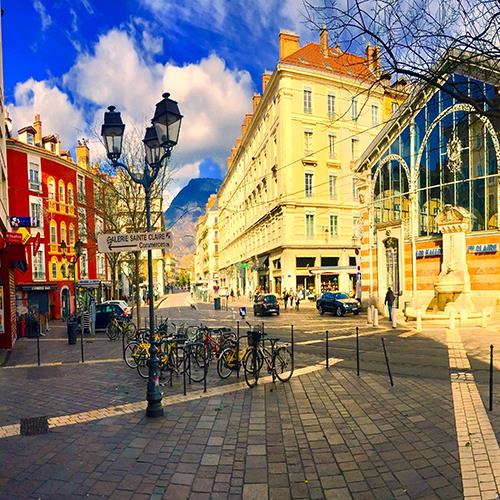

Vieille Ville (Old Town)
The historic city center, the Vieille Ville is filled with pedestrian-only streets beautifully lined with charming old houses and narrow cobblestone lanes leading to lively squares.
At the center of the Old Town, the Musée de l'Ancien Évêché is located in a 13th-century Episcopal palace, which is classified as a Historic Monument. The museum is home to Grenoble's history from ancient times through the Middle Ages until the 20th century.
Also located in the Old Town is the 13th to 15th century Cathédrale Notre-Dame. This beautiful church boasts a stunning high-vaulted Gothic interior, a striking contrast to its plain facade.
Next to the cathedral is the Place aux Herbes, where a traditional open-air farmers market is held every day (in the morning) except Mondays. Besides its inviting outdoor space and a pleasant sidewalk café, the square features a covered market hall that dates to the 19th century.
For those interested in French literature, be sure to pay a visit to the Musée Stendhal. It is located in a typical Bourgeois apartment that was the birthplace and childhood home of the French author Stendhal. This small museum houses mementos and gives an insight into Stendhal's early years.
At the nearby Place de Gordes, visitors can enjoy the lovely 18th-century atmosphere while dining at one of the restaurants or cafés with outdoor seating. A short walk from the Place de Gordes, the Jardin de Ville offers relaxation under the shady sycamore trees.
Also near the Jardin de Ville, the Ancien Palais de Justice (Palais du Parlement du Dauphiné) was the Parliament House of the Dauphiné Estates for more than 500 years. Stendhal based the character, Julien Sorel, in his novel Le Rouge et le Noir (The Red and the Black) on a historical figure who went to trial at the Palais de Justice.
The Palais du Parlement is found on the Place Saint-André next to France's second-oldest café, the Café de la Table Ronde, which dates to 1739.



Museums
You might not come to Grenoble expecting to find a good museum, but you’d be wrong. Grenoble counts no less than 15 museums covering a wide range of topics, from the most conventional to the most surprising. Discover temporary exhibitions or permanent collections, you can easily spend hours exploring the galleries taking in the local culture.
Check out the Mausoleium that dates to the year 521 at the fascinating Archaeological Museum. Here you’ll discover coins, pottery, stone epitaphs, glassware, and everyday items, that have all been placed back where they were found to add context for visitors.
Not far from the Archaeological Museum is the Dauphinois Museum boasting a great collection of history and culture of the Dauphiné Region. The cloister, garden, and baroque interiors, exemplified by the lovely ceiling in the chapel, all capture the imagination.
Musée de l’Ancien Évêché is Grenoble’s former Episcopal Palace. This free museum handles the history of the surrounding Isère Department. Like many of Grenoble’s other attractions, the building is a big ingredient, as the basement has the remains of the city’s Gallo-Roman wall, and what’s left of an early-Christian baptistery.
The Musée de la Résistance et de la Déportation offers detailed accounts of the local figures involved in sabotage and ambushes under the Vichy government. There’s also an overview of life in this region during the occupation, including the internment and deportation of Jews, other minorities, and political opponents.
TIP: If you’re under 26 you can get free entry to most museums in France!
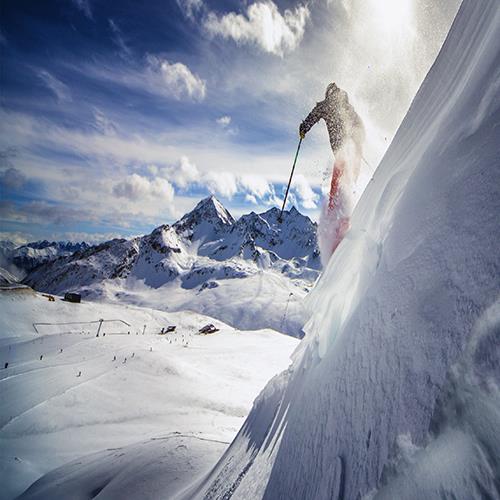
Winter Activities
In 1968 Grenoble hosted the Winter Olympics, so you’ll find there’s quite a bit of choice when it comes to ski resorts near Grenoble, one of the closest being Chamrousse. It’s just thirty minutes drive away from downtown Grenoble and is the locals’ ski resort. Many skiers favor 7 Laux, 28 miles northeast of the city, with 75 miles of slopes. About the same distance west of Grenoble is Autrans in the Vecors Massif. Autrans is all about cross country skiing, with more than 100 miles of trails for Nordic-style adventure. This is also a great area to try dog-sledding.
Other Grenoble ski resorts nearby include Les Deux Alps, Les Sept Laux and Alpe d’Huez. Grenoble to Les Deux Alpes and Alpe d’Huez is about 1.5 hours and to Les Sept Laux it’ll take about 1 hour.

Summer Activities
In the summer the ski resorts can help you access the natural wonders that are all the more beautiful when free of snow.
At almost 6,560-ft., the glacial Lac Achard freezes and has a layer of snow in the winter, but in summer the glorious cirque surrounding it is reflected in its tree-edged waters.
You can hike there on the GR-549, and it’s a pretty simple but scenic walk from Chamrousse.
On the same trail you can also walk to Les Lacs Robert, in a craggy, treeless landscape of needle-like peaks and meadow. If this walk is too taxing you can also let the ski lift take the strain, dropping you right by the southeast shore.